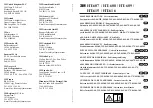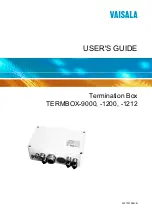
3
PAD-V
Machine description
INSTRUCTION
MANUAL
© MITA Cooling Technologies
S.r.l.
MITA-PAD-V-MAN-IT-
201812
25 / 59
Pos. 1. EC Axial motorised fan (electronically switched)
Low-noise axial fan, electronically controlled electric motor, protection grille and moulded metal sheet
inlet; it sucks in the air that passes through the finned batteries, ensuring heat exchange.
Pos. 2. Wetting water distribution channel
Made from AISI 304 stainless steel, this channel permits uniform distribution of the wetting water, by
gravity only, onto the adiabatic humidifier pack.
Pos. 3. Adiabatic air temperature probe
Detects the temperature of the ambient air in case of dry operation, and of the humidified air during
wet
operation.
Pos. 4. PVC Air inlet panels
These PVC panels are designed to prevent coarse foreign objects from entering the cooler (leaves,
pieces of paper, etc.), as well as to prevent "direct" sunlight exposure and accidental water splashing.
Easy to remove when cleaning and inspecting the humidifier pack.
Pos. 5. Adiabatic Humidifier pack
Made of flocked PVC, once wet, it slowly releases moisture into the transiting air flow ensuring
maximum humidification and maximum temperature reduction.
To ensure maximum efficiency, it must be kept clean and in optimum condition.
Pos. 6. Wetting water collection tank
Made of welded AISI 304, they collect the water dripping from the adiabatic humidifier pack and transfer
it to the sump in the recirculation kit.
Pos. 7. Cooled air temperature sensor
An NTC type which detects the temperature of the fluid in heat exchange battery outlet and provides the SET
POINT for control panel set-up.
Pos. 8. Heat exchange batteries
These are made from copper pipes with aluminium fins (or other suitable materials on request), arranged in a
V shape with an angle of between 35°
– 40°.
Each battery is fitted with bleed holes at the top of the manifolds and drain holes at the bottom.
The system delivery and return pipes must be connected to them.
CAUTION
In the event of replacement, it is advisable to use batteries which are the same as the
original to avoid any changes in flow resistance on the air side and machine
performance.
Pos. 9. Fluid do be cooled inlet connections
Of adequate diameter for the circulating flow rate.
Pos. 10. Cooled fluid outlets
Of an adequate diameter for the flow rate in circulation, these house the cooled fluid temperature probe.
















































